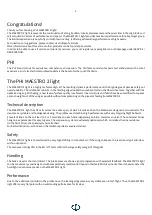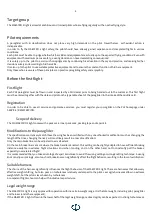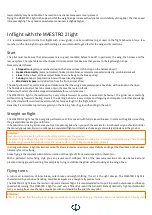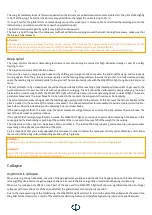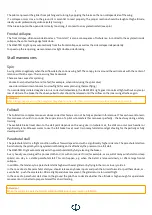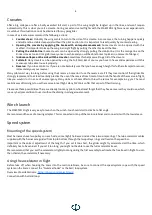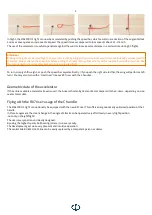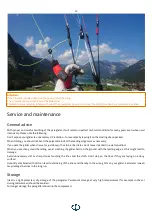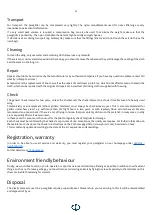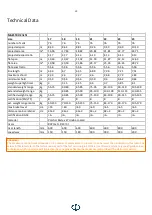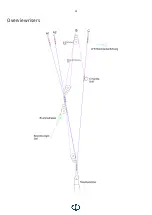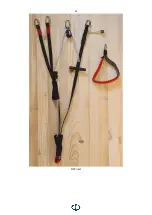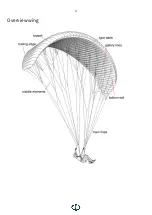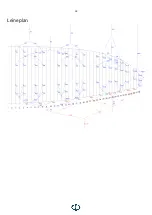
8
Cravates
A er a big collapse or a er a badly executed full stall, a part of the wing might be tangled up in the lines, and wonʼt reopen
automatically. This is what you call a cravate. During our extensive test flights with the MAESTRO 2 light we never experienced a
cravate but this situation can not be eliminated for any paraglider.
In case of a cravate we recommend the following actions:
1.
Counter steer:
Probably the wing wants to turn to the side of the cravate. In some cases, the turning happens quickly
and will end in a stable deep spiral without the pilotʼs action. So it is important to react quickly by counter steering.
2.
Opening the cravate by applying the brake with an impulse movement:
Some cravats can be opened with this
method. It is important to keep the wing in straight flight by pulling the other brake all the time.
3.
Pulling the stabilo line:
Some cravats can be opened by strongly pulling the stabilo line. (It is the orange line on the
B-riser. Have a look at it or grab it every once in a while and you will be able to react quicker in a moment of danger.)
4.
Induce a collapse on the side with the cravate.
Sometimes this helps as well to get rid of the cravate.
5.
Full stall:
Many cravats can be opened by using the Full Stall. But of course you have to have solid experience with this
maneuver to be able to use it properly.
6.
Reserve:
If you lose control or if you are not absolutely sure that you have enough height for further attempts to recover,
immediately use your reserve!
Many pilots wait way too long before using their reserve. Some donʼt use the reserve at all if they lose control of their glider. We
strongly recommend to at least mentally practice the use of the reserve from time to time: Grab the handle of the reserve in flight,
like you would do it in case of an emergency. Many clubs or schools offer to throw the rescue for example in a gym. The most
realistic way of training is to use the reserve in real flight. Many SIV Clinics offer that as part of their training.
Please use these possibilities: There are already too many pilots, who almost forgot that they have a reserve they could use, which
is a very bad precondition to use it without hesitating in a dangerous moment.
Winch launch
The MAESTRO 2 light is very easy to launch on the winch. You should start to climb at a flat angle.
We recommend the use of a towing adapter. This is connected on top of the main carabiner and connects it with the tow release.
Speed system
Mounting of the speed system
Most harnesses have two pulleys on each side, some (light) harnesses instead have two simple rings. The two accelerator cables
supplied with the harness are guided from top to bottom through the two pulleys / rings and fixed on the speed bar.
Important is the correct adjustment of the length. If you set it too short, the glider might fly accelerated all the time, which
definitely has to be avoided. If you set it too long, you might not be able to use the full accelerator travel.
We recommend that you set the accelerator slightly too long during the first assembly to estimate the free travel in flight. You can
then shorten the accelerator if necessary.
Using the accelerator in flight
Before take off, when hooking the risers into the main carabiners, be sure to connect the speed system rope with the speed
system on the risers: connect the “brummel hooks” or the ball / loop system.
Overview of available risers:
https://phi-air.com/project/risers/
Connection with ball and loop:
Summary of Contents for MAESTRO 2 light
Page 1: ...1 Manual Version 1 02 vom 19 09 2022 ...
Page 12: ...12 PHI PHI eine Marke der Papesh GmbH Grillparzerstrasse 10 6067 ABSAM Österreich ...
Page 14: ...14 Overview risers ...
Page 15: ...15 R07 riser ...
Page 17: ...17 Overview wing ...
Page 18: ...18 Leineplan ...


